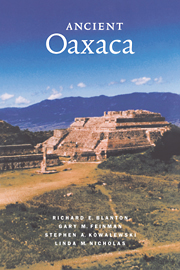Book contents
5 - Synthesis and conclusions
Published online by Cambridge University Press: 05 June 2012
Summary
In the last chapter, we looked at the implications of a new political order in the Valley of Oaxaca, drawing on findings from regional archaeological surveys, site excavations, and the interpretation of carved stone monuments. We now step back and consider this historical sequence from a more theoretical and comparative perspective. How does the ancient Oaxacan case relate to what we know about other early states and their development?
First, Period I in the Valley of Oaxaca was one of the world's relatively few instances of primary state formation. No other states existed, so far as we know, at this time elsewhere in Mesoamerica. Period I is therefore of considerable theoretical importance for understanding the process of state formation in general. How and why do people construct states when they lack any model or prior knowledge of similar political systems? What form will this new type of government take, what functions will it exercise, and how can it become widely accepted in society as a legitimate power? We try to understand what factors led to the eventual enactment of a new political course for the region.
We need not assume that the early state in Oaxaca was entirely a planned phenomenon. Many of the processes involved were probably responses to unanticipated events, and it is unlikely that there was a unanimity of opinion about the nature of the new political system or even whether there should be one. Separate factions probably had differing views of the ideal nature of government, and some probably resisted the development of a state.
- Type
- Chapter
- Information
- Ancient Oaxaca , pp. 111 - 132Publisher: Cambridge University PressPrint publication year: 1999

